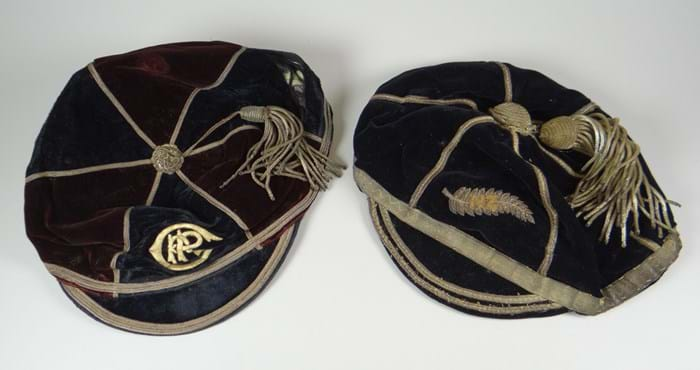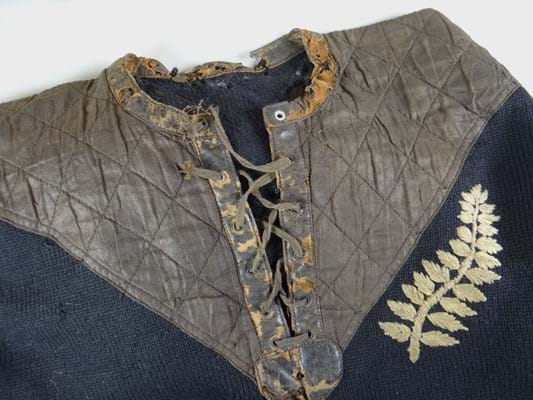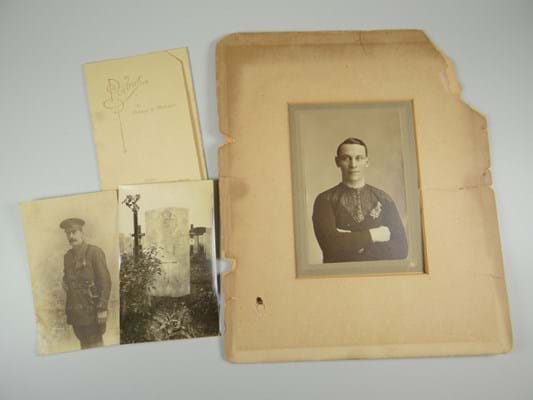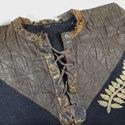The touring side became known as 'The Originals' and for the first time the nickname 'The All Blacks' was used by the British press, and memorabilia from the era is hotly contested by collectors.
The record came for Dave Gallaher’s 1905 All Blacks jersey and the shirt for sale on March 1 in Cardiff is that of Hubert Sydney Turtill from the same year, albeit not on the ‘Invincibles’ tour, and his only All Black appearance.
Turtill – like Gallaher – was one of the 13 All Blacks who were killed in the First World War.
His shirt is offered together with two caps (one NZ, the other Canterbury) and is estimated at £30,000-40,000. The New Zealand-born vendor is Turtill’s great-great grandson.
Gallaher’s shirt was bought through a phone bid by a figure who is well known in the rugby and sport memorabilia worlds: Nigel Wray, the chairman of Saracens rugby club and owner of a private collection of sporting memorabilia, the Priory Collection.

'Jum' Turtill's caps being sold alongside his All Blacks rugby shirt from 1905, all estimated at £30,000-40,000 in the March 1 Rogers Jones auction.
Switch to rugby league
‘Jum’ Turtill was one of the most gifted full-backs of the Edwardian era, although his number of All Blacks caps was curtailed to a single test as he became the infamous ‘dual-code player’ - switching to the All Gold rugby league professionals.
The shirt has an embroidered fern badge and iconic stitched canvas quilt overlaid to the upper section, complete with original drawstring.
Along with the caps, the lot also includes original black and white photographs of Jum, and two original caricature sketches of him in playing action, by the famous Beano cartoonist Reg Carter, both signed and dated 1908.
Turtill was born on February 1, 1880, in Mile End, London a few days after his father died, aged only 32. At the age of four, once strong enough for the long sea-voyage, his mother Alice took Sydney and her young family to New Zealand for a new life, a country where she had relatives.
During the voyage, Sydney was bestowed the nickname ‘Jumbo’ because of his puppy-fat, which later became simply ‘Jum’ and this name stuck despite Jum developing a fine athletic frame as he grew into a young man.
New life in New Zealand
The Turtills settled in Christchurch. By 1898 Jum was full-back for the Christchurch Albion club B team and was promoted to the A team the next year at the age of 19. At 22, Jum made his Canterbury debut as full-back, playing nine games that season.
In 1905, he was selected for a Canterbury-South Canterbury combined XV against Australia which they won 8-3 at Lancaster Park.
On the same day it was announced that he had been selected for New Zealand v Australia. This was to be the first test to be hosted in New Zealand between the two sides and the first international to be played on the South Island. The match venue was transferred from Dunedin’s Caledonian ground to Tahuna Park because heavy rain had made the former unplayable and so it was watched by only 3000 spectators. New Zealand won 14-3 and it was said that Jum excelled with a perfect display of kicking and defending despite the conditions.
However, it was to be his only All Blacks cap. Jum played his last club game on July 6, 1907, the same day as the Professional All Blacks team was selected for a tour to England. He had signed up for the privately organised tour where they would play ‘Northern Union’ rules (i.e. rugby league). It is said that Jum had been attracted to the prospect of visiting his country of birth.
The pioneering professional team visited Sydney, where they defeated New South Wales three times in eight days but playing rugby union rules. The Australian press nicknamed the New Zealanders the ‘All Golds’ - a reference to the slice of the gate-money to be received in England.
The tourists also defeated Ceylon (Sri Lanka) playing union rules. It wasn’t until they arrived in England in October 1907 that the players actually learned the league code. Over the next five months, through to February 1908, the All Golds played 35 league matches, mainly against club teams, winning 19 times.
Jum excelled at fullback playing in all but two of the matches. International tests were played against Wales (lost 9-8), England (lost 18-16) and Great Britain (lost 14-6, won 18-6 and won 8-5). The British press referred to the team as the ‘All Blacks’ while the Southern Hemisphere press tended to use ‘All Golds’. On their return the tourists played a further 10 games in Australia including three tests with Jum captaining the first league test between the two countries, leading New Zealand to an 11-10 victory. The All Golds won the series 2-1.
In all, the team toured for 10 months, playing 49 games and beating both Great Britain and Australia to a test series. When the All Golds finally arrived back in New Zealand, they played an exhibition match at Wellington which was the first-ever match of rugby league in the country and captained by Jum. After the tour he returned to normal life working as a sheet metal worker and married Mabel Edith Hancock in 1908.

Caricatures of 'Jum' Turtill, whose All Blacks rugby shirt from 1905 is estimated at £30,000-40,000 in the March 1 Rogers Jones auction.
Return to England
In 1909 he lost his job, a twist of fate that changed his life and ultimately may have cost it. As a way out Jum accepted an offer from the St Helens club in Lancashire with a signing-on fee of £200 and £2.2/- per game. He played his first match for St Helens on September 9 and set himself up as a tobacconist. The couple had three sons born in England. His career continued until he retired at the end of the 1913-14 season.
During his five years at St Helens he played 137 games, scoring three tries and kicking 198 goals amassing 403 points. He ran the Nelson Hotel in St Helens and looked forward to a settled life as a well-known and respected publican of the town.
But at the outset of war, Jum joined the Royal Engineers and was part of the Territorial Force the 422nd Field Company, which was under command of the 55th (West Lancashire) Division.
He survived massacres at Pilkem Ridge and Menin Road Ridge, but on April 9, 1918, Jum was killed at Givenchy from a shell burst, at the age of 38.









